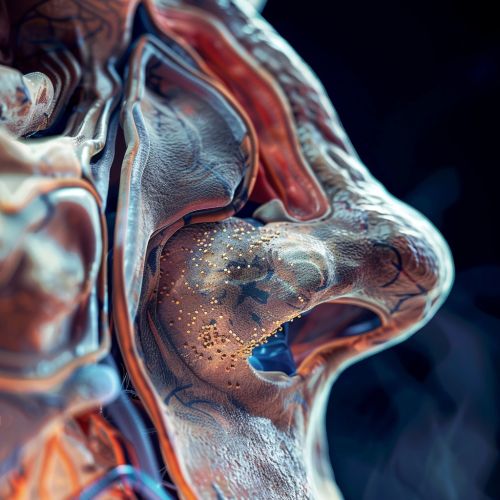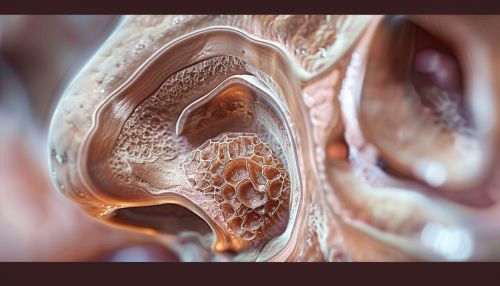Olfaction
Introduction
Olfaction, also known as the sense of smell, is one of the five traditional senses. It involves the detection and perception of chemicals floating in the air. The process of olfaction occurs when odorant molecules bind to specific sites on the olfactory receptors, which are located in the nasal epithelium. These receptors are part of the olfactory system, which transmits the signals to the brain via the olfactory bulb.
Anatomy of the Olfactory System
The olfactory system is the sensory system used for olfaction. This system includes the organs and cells contributing to the sense of smell. The primary components of the olfactory system are the olfactory epithelium, the olfactory bulb, and the olfactory cortex.


Olfactory Epithelium
The olfactory epithelium is a specialized epithelial tissue inside the nasal cavity that is involved in smell. It is a small patch of tissue, about 2.5 square centimeters, located at the roof of the nasal cavity. The olfactory epithelium is the part of the olfactory system where the actual detection of odorants takes place.
Olfactory Bulb
The olfactory bulb is a neural structure of the vertebrate forebrain involved in olfaction. It is the first brain structure to process olfactory information, receiving input from the olfactory receptor neurons in the olfactory epithelium.
Olfactory Cortex
The olfactory cortex is a part of the brain used for the processing of olfactory information. It is located in the temporal lobe of the brain and is a component of the limbic system.
Olfactory Process
The process of olfaction begins with the inhalation of odorant molecules into the nose, where they are detected by the olfactory receptors in the olfactory epithelium. The olfactory receptors are neurons equipped with olfactory hairs, which trap the odorant molecules and initiate an electrical signal.
The electrical signals are transmitted to the olfactory bulb, where they are processed and relayed to the olfactory cortex of the brain. The olfactory cortex then interprets these signals as specific smells. This entire process, from the moment the odorant molecules reach the olfactory epithelium to the brain's interpretation of the smell, takes place in less than a second.
Olfactory Disorders
Olfactory disorders are conditions that affect the sense of smell. They can be caused by a variety of factors, including aging, viral infections, brain injury, and exposure to toxic chemicals. The two most common types of olfactory disorders are anosmia and hyposmia.
Anosmia
Anosmia is the inability to perceive odor or a lack of functioning olfaction. This disorder can be either temporary or permanent, and it can be caused by a variety of factors, including head trauma, certain diseases, and certain medications.
Hyposmia
Hyposmia is a reduced ability to smell and to detect odors. Like anosmia, hyposmia can be either temporary or permanent, and it can be caused by a variety of factors.
